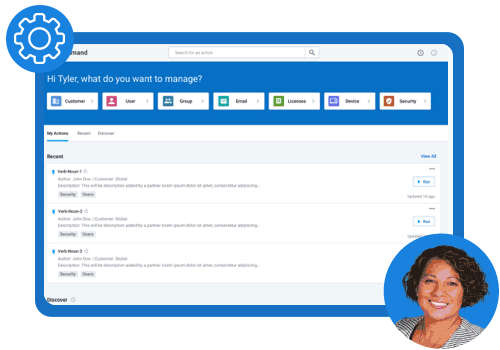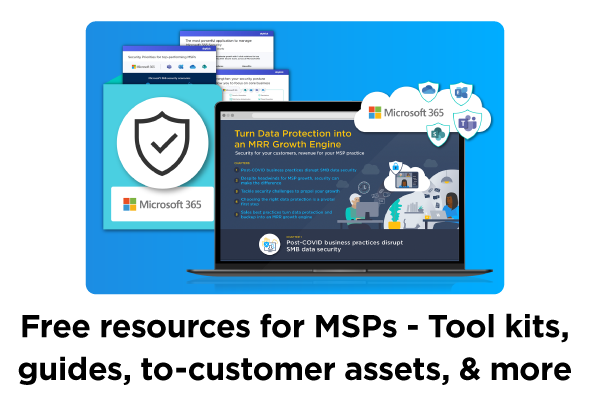Delivering secure, efficient, high-quality support services in a rapidly evolving SaaS world
In this Partner Spotlight, Sweden-based Office Management discusses how Cloud Manager is helping to take their business, and customer support, to the next level.

Like most managed service providers (MSPs), Stockholm, Sweden-based Office Management is always searching for ways to deliver the most secure, efficient, high-quality support services in a rapidly evolving SaaS world – which presents the challenge of managing multiple tenants across multiple portals and applications, on multiple platforms.
“In most cases, our service desk is the only contact our customer has with us as a company. So resolving support tickets swiftly is critical to maintaining and growing our customer-base,” says Roger Karlsson, Office Management’s Presales Specialist.
If not resolved by Tier 1, Roger emphasizes the need for efficient resolution by Tier 2 or Tier 3. As Roger puts it, getting “control of who did what when” is key to ensure that when tickets are escalated or something goes wrong, the Tier 2 or Tier 3 engineer can quickly see and act upon what happened and where things stand.
Additionally, and like many MSPs, Office Management is always looking for ways to add value for their customers. All of this and more, Office Management recently discussed with SkyKick as they reviewed how Cloud Manager helps them address these priorities.
Cloud Manager gives MSPs one application to command the cloud
Purpose-built for multi-tenant MSP practices, Cloud Manager is a highly-scalable SaaS-based application for managing entire cross-cloud, cross-tenant, cross-portal and hybrid environments from a single pane of glass.
As Office Management discovered, Cloud Manager offers a better way for MSPs to automate their cloud business. Cloud Manager sets the Help Desk up as a champion for the customer and sets the entire firm up for greater service quality, profitability, and customer satisfaction.
Creating efficiency across the entire customer lifecycle
“When Cloud Manager was presented to us,” Roger shares, “we were already using SkyKick for mail migration and Cloud Backup. I saw that adding Cloud Manager would enable us to use SkyKick to manage the entire customer lifecycle to and in the cloud, including the onboarding and on-going management activities we do after the migration. I immediately saw the benefits of having one portal to accomplish many of our needs.”
“We decided to test Cloud Manager,” he adds, “and the internal feedback was direct. It was an easy product to use, simple to learn. It can reduce a complex process that normally takes an hour or more into just a few minutes and a few clicks.”
Cloud Manager provides the easy automation that makes Help Desks run smoothly
Many MSPs have tried to overcome these challenges by using manual checklists to standardize service delivery. But this approach can be error-prone, especially if performed by junior-level technicians who are less familiar with the nuances of the work and unique and changing portals.
Roger says that Office Management “tried to create a PowerShell script library. We even hired a few people to do this for us. But you have to update it to stay current because there are always new things you need to consider.”
With Cloud Manager, Office Management now has an extensive, well-organized, and easily searchable library of over 10,000 Microsoft cmdlets as well as SkyKick-authored cmdlets that interact with a growing list of non-Microsoft applications such as Dropbox, Google Workspace, Slack, and more. Office Management also takes advantage of Cloud Manager’s prebuilt, customizable out-of-the-box sample scripts that address many of tasks that MSPs do most often, such as onboarding new users into multiple applications at once. These are available for “point and click” use as is by Tier 1 technicians who typically do not know PowerShell.
Cloud Manager’s inventory of cmdlets—which SkyKick keeps up-to-date— can be quickly accessed and inserted in the Workbench editor to create or customize additional scripts or reviewed with a direct link to Microsoft or API documentation. And these scripts too can be published for the Tier 1 support staff to use over and over again.
This ability to empower Help Desk personnel to leverage PowerShell without having to know it can be a tremendous benefit.
As Roger observes, “In many cases it’s fine to complete day-to-day tasks in the cloud through a web browser, but at some point, you will have to connect with a tool like PowerShell to get the job done. Without Cloud Manager that means you need to find the correct admin credentials, locate and download the correct PowerShell modules and documentation, and find the correct commands to do the task at hand. If this is something you do not do regularly, it’s not only time-consuming, it can also be a bit scary since you can do a lot of damage if you do something wrong. With Cloud Manager it’s just a few clicks and you’re done.”
Plus, with Cloud Manager things are done the same way each time, without any worries about something being missed, regardless of which technician is doing the pointing and clicking. And everything is automatically recorded in the Activity log for review or if escalation is required.
Help desk automation improves the customer experience
Your Help Desk, the main point of contact between your company and your customers, exists to deal with problems. When customers call, they are often stressed, confused, and maybe angry. And they’re really hoping that the junior technicians who are your first line of support can quickly address their problem.
“Ideally,” Roger stresses, “we’re trying to resolve basic issues within a 15-minute window.” Cloud Manager makes that possible.
With Cloud Manager the frontline gets the tools and ability to automatically fix a wide range of problems. It automates and streamlines processes, especially those little issues that should be simple to handle but often are not. Repetitive things like user creation, archiving, and resetting passwords, each of which are handled differently by each application, become simple “point and click” functions.
The end result: fewer escalations and happier customers.
Proactive IT service management makes the client relationship more “sticky”
One of the keys to success for most MSPs is to find multiple ways to add value for their customers. Roger, for example, strives to become a trusted advisor. “How big is the chance they will go to a competitor,” he asks, “if I am involved in their decision-making?”
Office Management adds value through proactive IT service management, especially for establishing and safeguarding security and compliance. Cloud Manager’s ability to run cross-client, cross-SaaS queries or commands is a huge driver of this.
For example, to ensure that none of your customers have shut off multi-factor authentication (MFA), simply run the “Get All Microsoft 365 Client Users With MFA Off” sample command to check all of your customers at once and flag anything that is not what it should be. Then run one of the the “Enable Microsoft 365 MFA” sample commands to automatically fix the issue for a single user or all users at a customer.
Similarly, Cloud Manager can be used to look at Microsoft Secure Scores across all tenants, and then run automation that implements best practice settings to bring the low scores up.
Cloud Manager enables you to easily execute security assessments, enforce policies or remediate gaps, at scale. Both access and remediation take place quickly and easily, from a single pane of glass.
Audit trails, tokenized authentication & other factors increase security
As an MSP you must work to prevent data breaches in your customers’ systems as well as your own. Risks include exposure from improper use and storage of customer and admin credentials, potential misuse of PowerShell (a frequent cybercriminal attack target/tool), and more.
Cloud Manager addresses some security issues by design. For example, tokenized authentication eliminates the need for non-secure password sharing. You securely authenticate once to activate a connector, and after that access is governed by a role-based permissions system.
From the PowerShell standpoint, junior-level technicians work from a pre-vetted library of commands, while PowerShell engineers don’t have to wonder if they’re using the latest version of a cmdlet.
Cloud Manager makes it simple to proactively monitor and manage potential security problems…and to avoid issues in the first place by standardizing security settings and policies.
Plus, the extremely detailed automatic audit trail supports your problem solving and root cause analysis as well as your customers’ compliance documentation requirements.
Conclusion
The average company has 30+ SaaS apps, and MSPs may service hundreds of customers. Cloud Manager enables MSPs to conquer the complexity of cloud operations and gives IT teams access to features they can’t get in standard admin portals, let alone getting all of them in one place.
Cloud Manager “puts a bow” on the customer experience by enabling you to:
- Automate, manage, and secure your entire cloud operations
- Consistently deliver quality
- Reduce ticket escalations and overall ticket resolution time
- Reduce support costs
- Improve margins
- Provide proactive service management
- Increase customer satisfaction
“Cloud Manager,” Roger concludes, “is helping us take our business, and the level of service and support that we offer our customers, to the next level. We are very glad we decided to give it a try!”
Learn more key ways that you can use Cloud Manager to grow your cloud business in Microsoft and beyond – and delight your customers.


